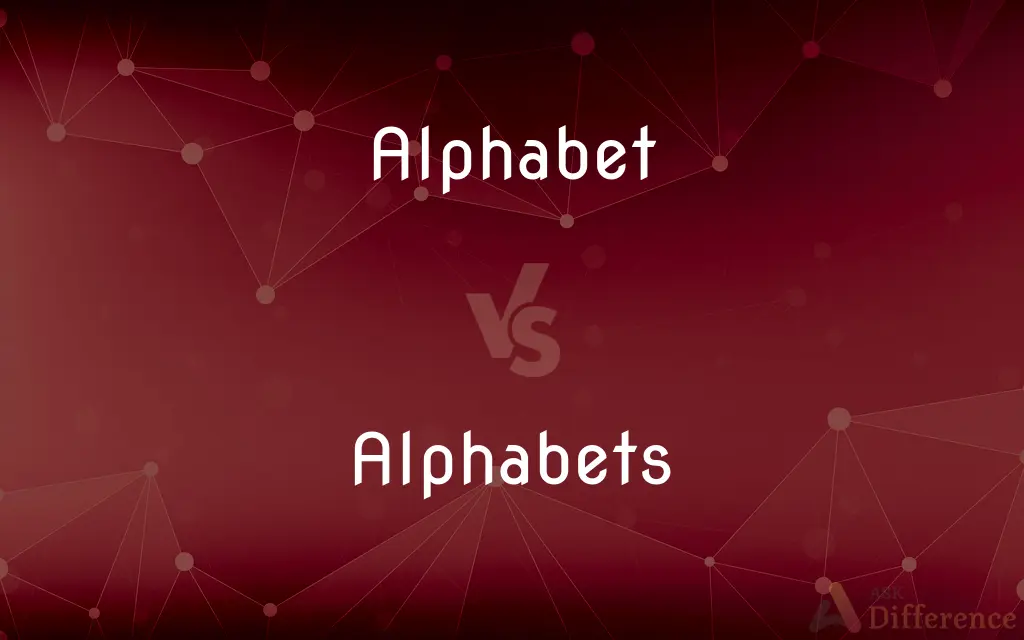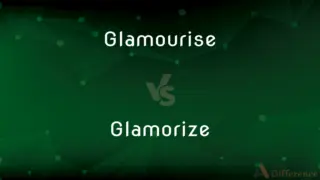Alphabet vs. Alphabets — What's the Difference?
Edited by Tayyaba Rehman — By Fiza Rafique — Updated on March 14, 2024
An alphabet is a set of letters used in a language, while "alphabets" refers to multiple such sets or the plural form, indicating more than one language or system.

Difference Between Alphabet and Alphabets
Table of Contents
ADVERTISEMENT
Key Differences
An alphabet is a standardized set of letters or symbols that represent the phonemes of a spoken language. It is used in the writing system of a language to form words and convey meaning. On the other hand, the term "alphabets" is used when referring to multiple alphabetic systems or when discussing the alphabets of different languages collectively.
Each alphabet is designed to represent the specific sounds of a language, allowing for the phonetic transcription of speech. Alphabets can vary significantly in size and complexity, with some languages having a few dozen characters, while others may have more. In contrast, when we refer to "alphabets," we acknowledge the diversity and variety of writing systems across languages, highlighting the cultural and linguistic differences that exist worldwide.
The concept of an alphabet allows for the systematic and standardized communication within a language community. It facilitates learning, literacy, and the dissemination of information. Whereas, talking about "alphabets" in the plural sense often occurs in contexts of comparative linguistics, education, and the study of writing systems, emphasizing the study and appreciation of multiple languages.
Some languages share the same alphabet, with minor variations in letters or pronunciation, showing the interconnectedness of cultures and linguistic evolution. Meanwhile, discussing "alphabets" can highlight the distinctions between these systems, even within languages that seem closely related, revealing subtle differences in their development and usage.
In certain contexts, "alphabet" can also refer to the basic fundamentals or principles of a subject, metaphorically denoting the foundation. "Alphabets," however, rarely sees such metaphorical use and remains more firmly rooted in discussions of language and writing systems, underscoring the multiplicity and richness of human communication methods.
ADVERTISEMENT
Comparison Chart
Definition
A set of letters of a particular language.
Multiple sets of letters from different languages.
Use
To write and represent one language.
To refer to or compare multiple writing systems.
Significance
Fundamental to literacy and communication in one language.
Highlights diversity and comparison among languages.
Linguistic Focus
Specific to a single language’s phonemes and sounds.
Comparative or pluralistic linguistic studies.
Contextual Use
Educational, communicational, foundational.
Educational, comparative linguistics, multicultural studies.
Compare with Definitions
Alphabet
Represents the basic sounds of a language.
Each letter in the alphabet corresponds to one or more sounds.
Alphabets
Highlights the cultural and historical backgrounds of languages.
Alphabets reflect the unique histories of the peoples who use them.
Alphabet
Foundation for literacy and communication within a language.
Learning the alphabet is the first step in reading.
Alphabets
Facilitates the understanding of linguistic plurality.
Learning about different alphabets broadens one's linguistic perspective.
Alphabet
Essential for the phonetic transcription of speech.
The alphabet allows for the accurate representation of spoken words.
Alphabets
Refers to the collective sets of letters from various languages.
The alphabets of the world exhibit a wide range of diversity.
Alphabet
A standardized set of letters used in writing a language.
The English alphabet consists of 26 letters.
Alphabets
Shows the evolution of written communication.
Ancient alphabets evolved into the modern ones we use today.
Alphabet
Can be adapted or modified over time.
The alphabet underwent changes to include letters for new sounds.
Alphabets
Used in comparative linguistics and studies.
Studying alphabets can reveal how languages influence each other.
Alphabet
An alphabet is a standardized set of basic written symbols or graphemes (called letters) that represent the phonemes of certain spoken languages. Not all writing systems represent language in this way; in a syllabary, each character represents a syllable, for instance, and logographic systems use characters to represent words, morphemes, or other semantic units.The first fully phonemic script, the Proto-Canaanite script, later known as the Phoenician alphabet, is considered to be the first alphabet, and is the ancestor of most modern alphabets, including Arabic, Cyrillic, Greek, Hebrew, Latin, and possibly Brahmic.
Alphabets
The letters of a language, arranged in the order fixed by custom.
Alphabet
The letters of a language, arranged in the order fixed by custom.
Alphabets
A system of characters or symbols representing sounds or things.
Alphabet
A system of characters or symbols representing sounds or things.
Alphabets
A set of basic parts or elements
"genetic markers ... that contain repeated sequences of the DNA alphabet"(Sandra Blakeslee).
Alphabet
A set of basic parts or elements
"genetic markers ... that contain repeated sequences of the DNA alphabet"(Sandra Blakeslee).
Alphabets
Plural of alphabet
Alphabet
The set of letters used when writing in a language.
The Greek alphabet has only twenty-four letters.
In the first year of school, pupils are taught to recite the alphabet.
Alphabet
A writing system in which letters represent phonemes. Contrast e.g. logography, a writing system in which each character represents a word, and syllabary, in which each character represents a syllable.
Alphabet
A writing system in which there are letters for the consonant and vowel phonemes. Contrast e.g. abjad.
Alphabet
(computer science) A typically finite set of distinguishable symbols.
Let be a regular language over the alphabet .
Alphabet
An individual letter of an alphabet; an alphabetic character.
Alphabet
The simplest rudiments; elements.
Alphabet
An agent of the FBI, the CIA, or another such government agency.
Alphabet
(rare) To designate by the letters of the alphabet; to arrange alphabetically.
Alphabet
The letters of a language arranged in the customary order; the series of letters or signs which form the elements of written language.
Alphabet
The simplest rudiments; elements.
The very alphabet of our law.
Alphabet
To designate by the letters of the alphabet; to arrange alphabetically.
Alphabet
A character set that includes letters and is used to write a language
Alphabet
The elementary stages of any subject (usually plural);
He mastered only the rudiments of geometry
Common Curiosities
What is an alphabet?
An alphabet is a system of letters used to represent the sounds of a language, forming the basis of its written form.
Can alphabets change over time?
Yes, alphabets can evolve, with letters being added, removed, or modified to better represent the sounds of the language.
How many letters are in an alphabet?
The number of letters in an alphabet varies by language, from the 26 letters of the English alphabet to the larger sets in other languages.
Why study different alphabets?
Studying different alphabets can offer insights into linguistic, cultural, and historical connections and differences among languages.
What is the significance of learning multiple alphabets?
Learning multiple alphabets can enhance linguistic skills, cultural understanding, and facilitate the learning of additional languages.
What does "alphabets" refer to?
"Alphabets" refers to multiple sets of such letters or systems, typically from different languages or writing traditions.
How does an alphabet contribute to a language?
It provides a structured and standardized way to record and communicate the spoken language through writing.
Are all writing systems based on alphabets?
No, there are several types of writing systems, including syllabaries and logographic systems, not all of which are alphabetic.
How are alphabets created?
Alphabets are developed through a process that codifies the sounds of a language into a set of symbolic representations.
What is the oldest known alphabet?
The oldest known alphabet is Proto-Sinaitic, dating back to around 1800 BCE.
How do digital technologies impact the use of alphabets?
Digital technologies facilitate the use, learning, and preservation of alphabets, especially those of minority languages or scripts at risk of extinction.
How do alphabets affect literacy?
The structure and complexity of an alphabet can influence the ease with which people can become literate in a language.
What challenges do multilingual individuals face with multiple alphabets?
Multilingual individuals may face challenges such as adapting to different writing directions, letter shapes, and sound representations.
Do all languages have an alphabet?
Not all languages use alphabetic writing systems; some use other systems like syllabaries or logograms.
Can alphabets be used metaphorically?
Yes, "alphabet" can metaphorically refer to the basic elements or principles of any system or field of knowledge.
Share Your Discovery

Previous Comparison
Glamourise vs. Glamorize
Next Comparison
Timber vs. WoodAuthor Spotlight
Written by
Fiza RafiqueFiza Rafique is a skilled content writer at AskDifference.com, where she meticulously refines and enhances written pieces. Drawing from her vast editorial expertise, Fiza ensures clarity, accuracy, and precision in every article. Passionate about language, she continually seeks to elevate the quality of content for readers worldwide.
Edited by
Tayyaba RehmanTayyaba Rehman is a distinguished writer, currently serving as a primary contributor to askdifference.com. As a researcher in semantics and etymology, Tayyaba's passion for the complexity of languages and their distinctions has found a perfect home on the platform. Tayyaba delves into the intricacies of language, distinguishing between commonly confused words and phrases, thereby providing clarity for readers worldwide.
















































